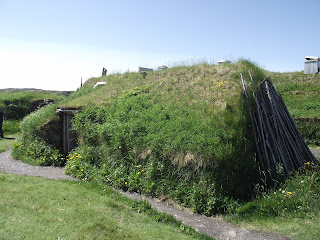 |
| Blacksmith's Shop, L'Anse Aux Meadows, Nfld |
 |
| Longhouse and other Buildings |
Hiding In Plain Sight.
So, how do you hide a village? Why in plain sight of course. You just need to design your village to look like the surrounding area. Here are a few buildings, reconstructions of what things may have looked like around 1000 AD when the Vikings first arrived on Newfoundland. From the sea, this building style would have been very difficult to see, unless you know what to look for. With the rocks and small islands offshore most vessels would have keep at least a half kilometre from shore. From more than two kilometres without the aid of optical devices these buildings would be all but invisible to the naked eye.How are they built? These are sod and timber framed structures. The walls are constructed from 2 foot wide strips of sod. The strips are laid with a 2 foot layer on the inside, with a 2 foot channel filled with gravel (for moisture management) and a final 2 foot strip on the outside. This makes a 6 foot thick wall. The walls are 4 to 5 feet tall and every three or so layers of sod, a 6 foot strip of sod is placed to tie the inner and outer layers together. The size of the building would dictate how many of these strips would be required for a given wall. The roof would be framed with available logs or timbers harvested and modified for the building being built. The roof would be "shingled" with sod to create a living roof. These building blend in with their environment because they are built from their environment. Sod is an excellent building material in locations where there is nothing.
 |
| Metalshop and Church, Norstead Village, Nfld |
 |
| Longhouse, Norstead Village, Nfld |
 |
| Fort Beausejour/Fort Cumberland, NB |
 |
| Example of a Good Defendable Location |
 |
| Defendable Location, Opposite Side |
Once you have mastered building a community with the resources available from the local environment consideration must be given to defence. An environmently friendly community is nice, but if you cannot protect it or defend it, you will lose it. The layout of your village is important. The location of your village is important. There are some "must have's" and some "nice to have's" that you will want inside the village. Water. You must have a source of water inside your village. It does not matter if it is a well, cistern, creek, spring or lake. You must have water. Food. You must have a supply of food. Food storage is good. Gardens are very good. Grain fields are nice, but unlikely to fit. Chickens for eggs and meat. Rabbits for meat. Goats or cows for milk, cheese, butter and meat. Sheep for wool and meat. These animals can live in a village with you. A source of heat for warmth or cooking. Firewood, coal, natural gas or even solar. Having a complete, stand-alone village is the goal. Self-sufficient and self-supporting. Working together for the common survival of all villagers.
However, once you have what other want you end up with problems arriving at your doorstep. So, you must be able to defend what you have. Of course, charity to those in need is necessary from time-to-time. And a supply of charitable goods should be on hand, but other are more ruthless. They do not want your kindness. They want to take everything away. They cannot be bought, unless the chains of your bondage to their slavery counts. To be defendable, you must locate your village so it can be defended. The last two pictures illustrate a possible defendable location. The large rock outcrop could be fortified with walls and shelters and one or two gates. The village itself could be located on the back side of the rock outcrop. A road to the water's edge would make sense, along with a wharf/dock, and a small port fortress. In an uncertain future that may have to re-learn the ways of olde. Villages will have to take care of themselves. Marauders will descend upon undefended villages and rape, pillage and plunder. The wolves will be out for blood, your blood. So, if you were to locate your village near this rock outcrop you will also want to have a flank security in the form of some sort of observation/listening posts that have communications with your village. AND an overwatch position on the hill behind your village. This leaves the most likely approach by water. If your attackers do not have artillery or mortars you should have an above average likelihood of surviving hostile acts against your village.
Of course, for defence and resource procurement you will want to have patrols out at all times. Both on the water and in the hills.
If you do not have the skills to plan, build or design a village; now is the best time to gather some of the basic skills. Tomorrow may be too late.
Keep your head when others are losing theirs!
Mountainman.
No comments:
Post a Comment